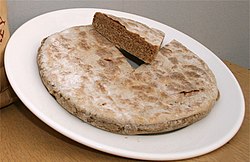Top Qs
Timeline
Chat
Perspective
Bannock (British and Irish food)
Type of flat quick bread From Wikipedia, the free encyclopedia
Remove ads
A bannock is a variety of flatbread or quick bread cooked from flour, typically round, which is common in Scotland and other areas in Britain and Ireland, as well as in Indigenous Canadian cookery. They are usually cut into sections before serving.
Remove ads
Etymology
The word bannock comes from northern English and Scots dialects. The Oxford English Dictionary states the term stems from panicium, a Latin word for "baked dough", or from panis, meaning bread. It was first referred to as "bannuc" in early glosses to the 8th-century author Aldhelm (d. 709),[1] and its first cited definition in 1562. Its historic use was primarily in Ireland, Scotland and Northern England.[2] The Scottish poet Robert Burns mentions a bannock in his Epistle to James Tennant of Glenconner, in reference to Alexander Tennant.[3]
Remove ads
Early history


The original bannocks were heavy, flat cakes of unleavened barley or oatmeal dough formed into a round or oval shape, then cooked on a griddle (or girdle in Scots). In Scotland, before the 19th century, bannocks were cooked on a bannock stane (Scots for stone), a large, flat, rounded piece of sandstone, placed directly onto a fire, used as a cooking surface.[4] Most modern bannocks are made with baking powder or baking soda as a leavening agent, giving them a light and airy texture.[5][6][7]
Remove ads
Varieties
Summarize
Perspective
Bannock varieties can be named or differentiated according to various characteristics: the flour or meal from which they are made, whether they are leavened or not, whether they have certain special ingredients, how they are baked or cooked, and the names of rituals or festivals in which they are used. Historically, specially made bannocks were used in rituals marking the changing of the Gaelic seasons: St Bride's bannock for spring (1 February), Bealtaine bannock for summer (1 May), Lughnasadh or Lammas bannock for autumn harvests (1 August) and Samhain bannock for winter (end of October). Other special bannocks include:
- beremeal bannock,
- bride's bannock,
- cod liver bannock,
- cryin' bannock,
- fallaid bannock,
- fife bannock,
- Hogmanay bannock,
- Marymas bannock,[8]
- mashlum bannock,
- Michaelmas bannock,
- pease bannock,
- Pitcaithly bannock (a kind of shortbread flavored with almonds and citrus peel[9]),
- salt bannock,
- sautie bannock,
- silverweed bannock,
- St Columba's bannock,
- teething bannock,
- Yetholm bannock, and
- Yule bannock.[5]
Manx bonnag probably comes from the same root form as bannock and is made using similar ingredients.[10] In the north of England, bannocks are often made using pastry rather than a bread dough.
Selkirk bannock
Selkirk bannock from Scotland is well-known and named after the town in the Scottish borders where it is traditionally made. It is a spongy, buttery variety, sometimes compared to a fruitcake,[11] made from wheat flour and containing a very large quantity of raisins. The first known maker of this variety was a baker named Robbie Douglas, who opened his shop in Selkirk in 1859. When Queen Victoria visited Sir Walter Scott's granddaughter at Abbotsford, she is reputed to have taken her tea with a slice of Selkirk bannock.[12]
- Selkirk bannock
- An advertisement for Selkirk bannock
See also
- Damper
- Frybread
- Hardtack
- Thirlage ('bannock': payment of a handful of meal to a miller's servant)
- List of British breads
- List of quick breads
References
Further reading
External links
Wikiwand - on
Seamless Wikipedia browsing. On steroids.
Remove ads



